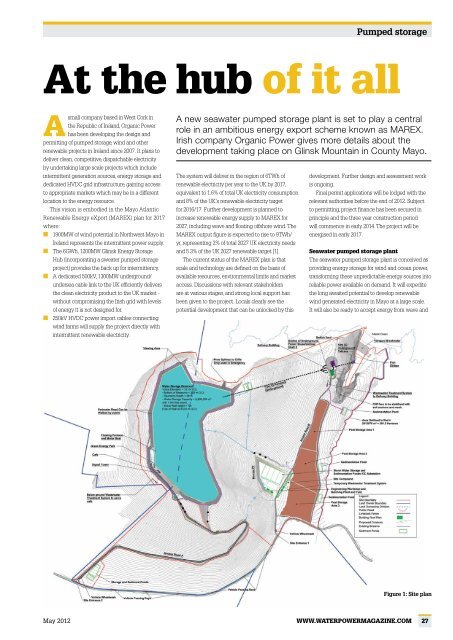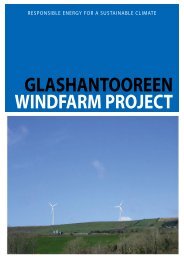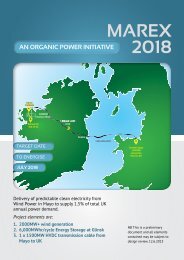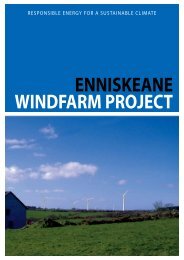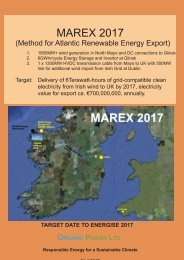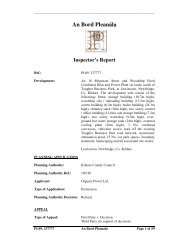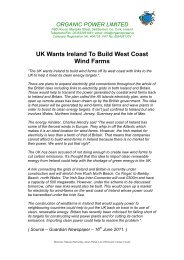at the hub of it all - Organic Power
at the hub of it all - Organic Power
at the hub of it all - Organic Power
You also want an ePaper? Increase the reach of your titles
YUMPU automatically turns print PDFs into web optimized ePapers that Google loves.
Pumped storage<br />
At <strong>the</strong> <strong>hub</strong> <strong>of</strong> <strong>it</strong> <strong>all</strong><br />
Asm<strong>all</strong> company based in West Cork in<br />
<strong>the</strong> Republic <strong>of</strong> Ireland, <strong>Organic</strong> <strong>Power</strong><br />
has been developing <strong>the</strong> design and<br />
perm<strong>it</strong>ting <strong>of</strong> pumped storage, wind and o<strong>the</strong>r<br />
renewable projects in Ireland since 2007. It plans to<br />
deliver clean, compet<strong>it</strong>ive, disp<strong>at</strong>chable electric<strong>it</strong>y<br />
by undertaking large scale projects which include<br />
interm<strong>it</strong>tent gener<strong>at</strong>ion sources, energy storage and<br />
dedic<strong>at</strong>ed HVDC grid infrastructure, gaining access<br />
to appropri<strong>at</strong>e markets which may be in a different<br />
loc<strong>at</strong>ion to <strong>the</strong> energy resource.<br />
This vision is embodied in <strong>the</strong> Mayo Atlantic<br />
Renewable Energy eXport (MAREX) plan for 2017<br />
where:<br />
■ 1900MW <strong>of</strong> wind potential in Northwest Mayo in<br />
Ireland represents <strong>the</strong> interm<strong>it</strong>tent power supply.<br />
■ The 6GWh, 1200MW Glinsk Energy Storage<br />
Hub (incorpor<strong>at</strong>ing a swe<strong>at</strong>er pumped storage<br />
project) provides <strong>the</strong> back up for interm<strong>it</strong>tency.<br />
■ A dedic<strong>at</strong>ed 500kV, 1300MW underground/<br />
undersea cable link to <strong>the</strong> UK efficiently delivers<br />
<strong>the</strong> clean electric<strong>it</strong>y product to <strong>the</strong> UK market -<br />
w<strong>it</strong>hout compromising <strong>the</strong> Irish grid w<strong>it</strong>h levels<br />
<strong>of</strong> energy <strong>it</strong> is not designed for.<br />
■ 250kV HVDC power import cables connecting<br />
wind farms will supply <strong>the</strong> project directly w<strong>it</strong>h<br />
interm<strong>it</strong>tent renewable electric<strong>it</strong>y.<br />
A new seaw<strong>at</strong>er pumped storage plant is set to play a central<br />
role in an amb<strong>it</strong>ious energy export scheme known as MAREX.<br />
Irish company <strong>Organic</strong> <strong>Power</strong> gives more details about <strong>the</strong><br />
development taking place on Glinsk Mountain in County Mayo.<br />
The system will deliver in <strong>the</strong> region <strong>of</strong> 6TWh <strong>of</strong><br />
renewable electric<strong>it</strong>y per year to <strong>the</strong> UK by 2017,<br />
equivalent to 1.6% <strong>of</strong> total UK electric<strong>it</strong>y consumption<br />
and 8% <strong>of</strong> <strong>the</strong> UK’s renewable electric<strong>it</strong>y target<br />
for 2016/17. Fur<strong>the</strong>r development is planned to<br />
increase renewable energy supply to MAREX for<br />
2027, including wave and flo<strong>at</strong>ing <strong>of</strong>fshore wind. The<br />
MAREX output figure is expected to rise to 9TWh/<br />
yr, representing 2% <strong>of</strong> total 2027 UK electric<strong>it</strong>y needs<br />
and 5.3% <strong>of</strong> <strong>the</strong> UK 2027 renewable target [1].<br />
The current st<strong>at</strong>us <strong>of</strong> <strong>the</strong> MAREX plan is th<strong>at</strong><br />
scale and technology are defined on <strong>the</strong> basis <strong>of</strong><br />
available resources, environmental lim<strong>it</strong>s and market<br />
access. Discussions w<strong>it</strong>h relevant stakeholders<br />
are <strong>at</strong> various stages, and strong local support has<br />
been given to <strong>the</strong> project. Locals clearly see <strong>the</strong><br />
potential development th<strong>at</strong> can be unlocked by this<br />
development. Fur<strong>the</strong>r design and assessment work<br />
is ongoing.<br />
Final perm<strong>it</strong> applic<strong>at</strong>ions will be lodged w<strong>it</strong>h <strong>the</strong><br />
relevant author<strong>it</strong>ies before <strong>the</strong> end <strong>of</strong> 2012. Subject<br />
to perm<strong>it</strong>ting, project finance has been secured in<br />
principle and <strong>the</strong> three year construction period<br />
will commence in early 2014. The project will be<br />
energised in early 2017.<br />
Seaw<strong>at</strong>er pumped storage plant<br />
The seaw<strong>at</strong>er pumped storage plant is conceived as<br />
providing energy storage for wind and ocean power,<br />
transforming <strong>the</strong>se unpredictable energy sources into<br />
reliable power available on demand. It will exped<strong>it</strong>e<br />
<strong>the</strong> long awa<strong>it</strong>ed potential to develop renewable<br />
wind gener<strong>at</strong>ed electric<strong>it</strong>y in Mayo <strong>at</strong> a large scale.<br />
It will also be ready to accept energy from wave and<br />
Figure 1: S<strong>it</strong>e plan<br />
May 2012 www.w<strong>at</strong>erpowermagazine.com 27
Pumped storage<br />
Figure 2: Reservoir<br />
embankment section<br />
flo<strong>at</strong>ing wind turbines (on a large scale) when this<br />
technology comes <strong>of</strong> age, targeted for 2027. It will<br />
also link <strong>the</strong> best wind resource in Europe to <strong>the</strong> UK<br />
market, delivering clean power when <strong>it</strong> is needed.<br />
The €480M project (excluding grid) is<br />
commerci<strong>all</strong>y compet<strong>it</strong>ive <strong>at</strong> a build cost <strong>of</strong> €400/<br />
kW excluding transmission systems. Construction<br />
will gener<strong>at</strong>e 200 jobs for three years and justify <strong>the</strong><br />
immedi<strong>at</strong>e rollout <strong>of</strong> a dedic<strong>at</strong>ed grid connection to<br />
<strong>the</strong> UK by 2017 as part <strong>of</strong> <strong>the</strong> MAREX plan.<br />
Using seaw<strong>at</strong>er <strong>all</strong>ows for larger and more<br />
economical schemes w<strong>it</strong>hout <strong>the</strong> need to use<br />
valuable and lim<strong>it</strong>ed freshw<strong>at</strong>er resources. It will<br />
also dict<strong>at</strong>e th<strong>at</strong> <strong>all</strong> wet elements are su<strong>it</strong>able for <strong>the</strong><br />
marine environment through <strong>the</strong> use <strong>of</strong> marine grade<br />
steel, concrete, plastics etc. Experience from <strong>the</strong><br />
oper<strong>at</strong>ion <strong>of</strong> <strong>the</strong> Yanbaru seaw<strong>at</strong>er pumped storage<br />
scheme by J<strong>Power</strong> in Okinawa, Japan since 1999 has<br />
shown th<strong>at</strong> seaw<strong>at</strong>er is perfectly adequ<strong>at</strong>e for use in<br />
such systems [2].<br />
Glinsk Mountain in County Mayo has been<br />
selected for this project because <strong>of</strong> <strong>it</strong>s almost unique<br />
qual<strong>it</strong>ies as a high, fl<strong>at</strong> topped, mountain. Loc<strong>at</strong>ed<br />
beside <strong>the</strong> sea, and not in an environment<strong>all</strong>y<br />
design<strong>at</strong>ed s<strong>it</strong>e, <strong>it</strong> is composed <strong>of</strong> very hard,<br />
impermeable and immensely stable schist rock.<br />
The project s<strong>it</strong>e faces <strong>the</strong> Atlantic Ocean and <strong>the</strong><br />
upper reservoir is loc<strong>at</strong>ed on <strong>the</strong> pl<strong>at</strong>eau <strong>of</strong> Glinsk<br />
Mountain where <strong>the</strong> reservoir base will be 288m asl<br />
and 700m from <strong>the</strong> coastal intake. The Glinsk project<br />
(see figure 1) will use <strong>the</strong> sea as <strong>the</strong> lower reservoir.<br />
The design concept carried out by erm21c is being<br />
advised on by J<strong>Power</strong>.<br />
A total <strong>of</strong> 8.9Mm 3 <strong>of</strong> seaw<strong>at</strong>er can be pumped to<br />
an average elev<strong>at</strong>ion <strong>of</strong> 292m asl to fill <strong>the</strong> reservoir<br />
from empty, providing 6.1GWh <strong>of</strong> storage per cycle.<br />
When released, <strong>the</strong> w<strong>at</strong>er from <strong>the</strong> reservoir will<br />
gener<strong>at</strong>e electrical power <strong>at</strong> 1200MW from <strong>the</strong> four<br />
variable speed 300MW reversible turbines for five<br />
hours. The scheme will accept energy <strong>of</strong>f peak for<br />
8-19 hours per day depending on <strong>the</strong> available<br />
wind energy. Electrical efficiency for <strong>the</strong> pumped<br />
storage plant has been modelled from <strong>the</strong> design<br />
<strong>at</strong> 75%.<br />
Electric power sourced from wind (and l<strong>at</strong>er<br />
ocean and flo<strong>at</strong>ing wind power) will provide <strong>the</strong><br />
input power during <strong>of</strong>f peak hours <strong>of</strong> electric<strong>it</strong>y<br />
demand. The facil<strong>it</strong>y will accept wind power from<br />
<strong>the</strong> planned 1900MW <strong>of</strong> wind turbines (in<strong>it</strong>i<strong>all</strong>y<br />
in 2017) during <strong>of</strong>f peak night time hours or<br />
when gener<strong>at</strong>ion exceeds demand, and use <strong>it</strong> to<br />
pump seaw<strong>at</strong>er to <strong>the</strong> reservoir on top <strong>of</strong> Glinsk<br />
Mountain [3]. The stored energy will be exported<br />
via HVDC link to <strong>the</strong> UK for use during peak<br />
times. The pumped storage scheme can deliver<br />
power <strong>at</strong> maximum output for five hours per day,<br />
approxim<strong>at</strong>ely corresponding to peak demand in<br />
<strong>the</strong> UK. It is fur<strong>the</strong>r planned to accept seaw<strong>at</strong>er<br />
pumped to <strong>the</strong> reservoir from 800MW <strong>of</strong> ocean<br />
energy pumps, and power from 500MW <strong>of</strong> potential<br />
flo<strong>at</strong>ing wind turbines for 2027.<br />
All above board<br />
More than 550,000m 3 <strong>of</strong> pe<strong>at</strong> must be removed from<br />
<strong>the</strong> summ<strong>it</strong> <strong>of</strong> <strong>the</strong> mountain to <strong>all</strong>ow for reservoir<br />
construction. This will be removed by transforming<br />
<strong>the</strong> pe<strong>at</strong> into a wet sludge and pumping <strong>it</strong> downhill<br />
through pipes to a holding reservoir, where <strong>the</strong> pe<strong>at</strong><br />
is dew<strong>at</strong>ered and <strong>the</strong> w<strong>at</strong>er returned uphill for fur<strong>the</strong>r<br />
sludge activ<strong>at</strong>ion. The system is a closed circu<strong>it</strong> w<strong>it</strong>h<br />
w<strong>at</strong>er cleaning systems incorpor<strong>at</strong>ed, and has been<br />
designed on advice from KOOP W<strong>at</strong>er Management<br />
<strong>of</strong> Holland.<br />
The reservoir embankment will be an earthquake<br />
resistant reinforced earth system grav<strong>it</strong>y retaining<br />
structure (see figure 2) constructed w<strong>it</strong>h rock from<br />
w<strong>it</strong>hin <strong>the</strong> s<strong>it</strong>e, based on designs from Terre-Armée/<br />
Reinforced Earth Company [4]. The geomembrane<br />
system consists <strong>of</strong> a geocompos<strong>it</strong>e. This is formed<br />
from an impermeable PVC geomembrane lamin<strong>at</strong>ed<br />
during manufacturing to a geotextile providing<br />
puncture resistance and increased dimensional<br />
stabil<strong>it</strong>y. The geocompos<strong>it</strong>e will be applied to <strong>the</strong> full<br />
face <strong>of</strong> <strong>the</strong> vertical w<strong>all</strong>s ei<strong>the</strong>r in front <strong>of</strong> (exposed<br />
configur<strong>at</strong>ion) or behind (covered configur<strong>at</strong>ion)<br />
<strong>the</strong> precast panel w<strong>all</strong>. PVC has excellent m<strong>at</strong>erial<br />
properties and we<strong>at</strong>her resistance characteristics<br />
28<br />
INTERNATIONAL WATER POWER & DAM CONSTRUCTION May 2012
Pumped storage<br />
Sea<strong>Power</strong> pl<strong>at</strong>form<br />
AWE waveroller<br />
and is commonly used to line pumped storage<br />
reservoirs. An asphaltic liner will be used to seal <strong>the</strong><br />
reservoir floor. The combined sealing system will<br />
securely prevent w<strong>at</strong>er leaking from <strong>the</strong> reservoir<br />
into <strong>the</strong> surrounding environment.<br />
A leakage mon<strong>it</strong>oring and detection system will<br />
be used to detect seaw<strong>at</strong>er leakage should damage<br />
to <strong>the</strong> sheet occur. Underne<strong>at</strong>h <strong>the</strong> sealing systems<br />
<strong>of</strong> <strong>the</strong> reservoir a drainage system will be inst<strong>all</strong>ed<br />
in order to intercept possible leakage w<strong>at</strong>er. A<br />
fibre-optic leakage detection and localis<strong>at</strong>ion<br />
system (based on <strong>the</strong> he<strong>at</strong>-pulse method developed<br />
by GTC Kappelmeyer GmbH [5]) will be f<strong>it</strong>ted to<br />
pinpoint possible leaks <strong>at</strong> cr<strong>it</strong>ical points. This online<br />
autom<strong>at</strong>ic system will enable immedi<strong>at</strong>e action<br />
to empty <strong>the</strong> reservoir in case <strong>of</strong> leak detection.<br />
It will prevent sea w<strong>at</strong>er from leaking into <strong>the</strong><br />
neighbouring environment. As <strong>the</strong> PVC sheet and<br />
asphaltic are <strong>the</strong> top layers <strong>of</strong> <strong>the</strong> lining structure,<br />
<strong>the</strong>y can be repaired.<br />
Going underground<br />
To preserve <strong>the</strong> landscape in <strong>the</strong> area, <strong>the</strong> penstock<br />
and powerhouse will be excav<strong>at</strong>ed underground. The<br />
6.9m diameter penstock and 10m diameter tailrace<br />
will be assembled w<strong>it</strong>hin <strong>the</strong> excav<strong>at</strong>ed tunnel by<br />
mounting FRC concrete panels (multi-segment in <strong>the</strong><br />
diameter), which are grouted into place to maintain<br />
back pressure from <strong>the</strong> mountain (see figure 4). The<br />
powerhouse will be loc<strong>at</strong>ed 50m below sea level, and<br />
will consist <strong>of</strong> a cavern containing <strong>the</strong> pump turbines.<br />
This cavern will be accessed by a vertical 150m deep<br />
access shaft from <strong>the</strong> surface <strong>of</strong> <strong>the</strong> ground above.<br />
The cavern will be connected to <strong>the</strong> sea by a 120m<br />
long intake structure loc<strong>at</strong>ed below sea level in <strong>the</strong><br />
east facing cliff <strong>of</strong> <strong>the</strong> sea chasm.<br />
The w<strong>at</strong>er intake is from a sea chasm <strong>at</strong> <strong>the</strong> north<br />
eastern part <strong>of</strong> <strong>the</strong> s<strong>it</strong>e which provides wave shelter<br />
on three sides, w<strong>it</strong>h a porous breakw<strong>at</strong>er constructed<br />
to shelter <strong>the</strong> fourth side. The breakw<strong>at</strong>er is<br />
composed <strong>of</strong> a tetrapod/X-bloc mound wave<br />
<strong>at</strong>tenu<strong>at</strong>ion structure loc<strong>at</strong>ed <strong>at</strong> <strong>the</strong> mouth <strong>of</strong> <strong>the</strong><br />
sea chasm. The main functions <strong>of</strong> <strong>the</strong> tetrapod/Xbloc<br />
barrier will be: to minimise wave action and<br />
reduce w<strong>at</strong>er level fluctu<strong>at</strong>ion during pumping; and<br />
to dissip<strong>at</strong>e <strong>the</strong> energy <strong>of</strong> <strong>the</strong> ex<strong>it</strong>ing w<strong>at</strong>er post<br />
gener<strong>at</strong>ion and protect marine hab<strong>it</strong><strong>at</strong>.<br />
The w<strong>at</strong>er in <strong>the</strong> chasm will enter and ex<strong>it</strong> <strong>the</strong><br />
tailrace through a below-sea-level sluiced w<strong>at</strong>er<br />
intake structure, which will be constructed as a<br />
caisson <strong>of</strong>f s<strong>it</strong>e and flo<strong>at</strong>ed into place for submersion<br />
and fixing, prior to breakw<strong>at</strong>er construction. Once<br />
in place <strong>the</strong> caisson will be pumped out to <strong>all</strong>ow <strong>the</strong><br />
final tailrace breakout to be completed in dry working<br />
cond<strong>it</strong>ions.<br />
M<strong>at</strong>erials for <strong>the</strong> pump-turbine runner and <strong>the</strong><br />
guide vanes will be made from austen<strong>it</strong>ic stainless<br />
steel which has anti-cav<strong>it</strong><strong>at</strong>ion, anti-wear and anticorrosive<br />
characteristics. For high efficiency power<br />
gener<strong>at</strong>ion and pumping, a combin<strong>at</strong>ion <strong>of</strong> variable<br />
and fixed speed pump-turbines will be used.<br />
Figure 3: Pr<strong>of</strong>ile<br />
through w<strong>at</strong>erways<br />
May 2012 <br />
www.w<strong>at</strong>erpowermagazine.com<br />
29
Pumped storage<br />
Figure 4: Tailrace section<br />
w<strong>it</strong>h wave pump w<strong>at</strong>er<br />
delivery pipes<br />
Existing mountain pr<strong>of</strong>ile<br />
Wave pump pressurised delivery<br />
The inclusion <strong>of</strong> pressurised piped seaw<strong>at</strong>er delivery<br />
from wave pumps provides a market and pl<strong>at</strong>form for<br />
<strong>the</strong> development <strong>of</strong> wave energy conversion devices.<br />
Six 500mm diameter valved delivery pipes will be<br />
connected to <strong>the</strong> pressurised penstock upstream <strong>of</strong><br />
<strong>the</strong> powerhouse. Wave energy conversion developers<br />
are working on large scale un<strong>it</strong>s (see illustr<strong>at</strong>ions<br />
p29) which can pump high pressure w<strong>at</strong>er in large<br />
volumes and are designed specific<strong>all</strong>y for this type <strong>of</strong><br />
applic<strong>at</strong>ion, where electrical gener<strong>at</strong>ion components<br />
from wave energy convertors and associ<strong>at</strong>ed<br />
maintenance are elimin<strong>at</strong>ed. Sea-<strong>Power</strong> <strong>of</strong> Ireland<br />
and AWE <strong>of</strong> Finland are collabor<strong>at</strong>ing in a detailed<br />
assessment <strong>of</strong> supplying <strong>the</strong> Glinsk Energy Hub w<strong>it</strong>h<br />
pumped seaw<strong>at</strong>er.<br />
In <strong>the</strong> design <strong>of</strong> <strong>the</strong> Energy Storage Hub, pipe<br />
work has been incorpor<strong>at</strong>ed to <strong>all</strong>ow <strong>the</strong> equivalent<br />
<strong>of</strong> 200MW average electric power to be provided as<br />
pumped w<strong>at</strong>er from ocean energy devices. This array<br />
is proposed directly <strong>of</strong>fshore from <strong>the</strong> Glinsk Energy<br />
Hub, where sufficient depth and wave energy are<br />
available w<strong>it</strong>hin 1km. At a capac<strong>it</strong>y factor <strong>of</strong> 20-25%<br />
this would equ<strong>at</strong>e to an array <strong>of</strong> approxim<strong>at</strong>ely<br />
200x4MW wave pumps. Electric<strong>it</strong>y input to MAREX<br />
from such an inst<strong>all</strong><strong>at</strong>ion would equ<strong>at</strong>e to a range <strong>of</strong><br />
160-200MW, producing approxim<strong>at</strong>ely 1-1.3TWh/yr,<br />
after pumping losses.<br />
Environmental conserv<strong>at</strong>ion<br />
An Environmental Impact St<strong>at</strong>ement has been<br />
prepared by erm21c to assess <strong>the</strong> impact <strong>of</strong> <strong>the</strong><br />
project on <strong>the</strong> local environment. It details m<strong>it</strong>ig<strong>at</strong>ion<br />
measures to minimise impacts identified, including:<br />
■ Landscaping <strong>the</strong> new pr<strong>of</strong>ile <strong>of</strong> <strong>the</strong> mountain to<br />
minimise visual impacts <strong>of</strong> views <strong>at</strong> <strong>the</strong> proposed<br />
world her<strong>it</strong>age s<strong>it</strong>e Ceide Fields (pictured left).<br />
■ Reducing discharge veloc<strong>it</strong>y in <strong>the</strong> chasm to<br />
m<strong>it</strong>ig<strong>at</strong>e <strong>the</strong> impact <strong>of</strong> sea w<strong>at</strong>er discharge on<br />
marine life.<br />
■ Re-planting reservoir embankments w<strong>it</strong>h local<br />
flora from <strong>the</strong> s<strong>it</strong>e.<br />
■ Tre<strong>at</strong>ing soiled w<strong>at</strong>er gener<strong>at</strong>ed <strong>at</strong> <strong>the</strong><br />
construction s<strong>it</strong>e in sediment<strong>at</strong>ion ponds before<br />
discharging into n<strong>at</strong>ural streams.<br />
■ Sowing fodder for endangered bird species Tw<strong>it</strong>e<br />
Carduelis flavirostris in sacrificial plots [6]. ■<br />
References:<br />
[1] POYRY (December 2011), ‘Potential Impacts <strong>of</strong> Revised Renewables Oblig<strong>at</strong>ion Technology<br />
Bands’.<br />
[2] TANAKA KUNINORI Electr. <strong>Power</strong> Dev. Co., Ltd. (2004). ‘Pumped-Storage <strong>Power</strong> Plant<br />
Using Sea W<strong>at</strong>er’. Journal <strong>of</strong> <strong>the</strong> Inst<strong>it</strong>ute <strong>of</strong> Electrical Engineers <strong>of</strong> Japan.<br />
[3] Mayo County Council. (2011), ‘Renewable Energy Str<strong>at</strong>egy for County Mayo’<br />
[4] Terre Armée Intern<strong>at</strong>ionale (2012) ‘Sustainable Technology’. Available <strong>at</strong>: http://tinyurl.<br />
com/7s9wutb.<br />
[5] Aufleger M., J. Dornstädter, A. Fabr<strong>it</strong>ius, Th. Strobl (1998). Fibre Optic Temper<strong>at</strong>ure<br />
Measurements for Leakage Detection – Applic<strong>at</strong>ions in <strong>the</strong> Reconstruction <strong>of</strong> Dams.<br />
Proceedings: Repair and Upgrade <strong>of</strong> Dams. ICOLD-Symposium‚ Rehabil<strong>it</strong><strong>at</strong>ion <strong>of</strong> Dams‘ 4th<br />
November 1998, New Delhi, India.<br />
[6] Derek McLoughlin, MIEEM (2011) ‘Assessment <strong>of</strong> <strong>the</strong> Potential and Predicted Impacts on<br />
Tw<strong>it</strong>e Carduelis flavirostris <strong>of</strong> <strong>the</strong> Proposed Sea W<strong>at</strong>er Pumped Hydroelectric Storage<br />
Scheme (SWPHSS) <strong>at</strong> Glinsk Mountain, Co. Mayo’.<br />
30<br />
INTERNATIONAL WATER POWER & DAM CONSTRUCTION May 2012


